|
|
|
Sort Order |
|
|
|
Items / Page
|
|
|
|
|
|
|
| Srl | Item |
| 1 |
ID:
144703


|
|
|
|
|
| Summary/Abstract |
Since his inauguration on 29 May 2015, President Muhammadu Buhari has taken several practical, policy and diplomatic actions aimed at defeating the six-year long insurgency by Boko Haram terrorists in Nigeria. These actions have started to have a modest positive impact on reclaiming the territories previously held by the terrorists. Boko Haram has reacted by ramping up its attacks on soft targets and communities in the north-east. This article focuses on Boko Haram's bombing activities in Nigeria's capital city, Abuja. It shows that between 2011 and 2015, Boko Haram has staged nine bombings in Abuja, resulting in the deaths of at least 191 people, including suicide bombers. It argues that the October 2015 suicide bombings in Kuje and Nyanya, Abuja, represent Boko Haram's bold attempt to respond to President Buhari's counter-insurgency efforts. The article proposes the ‘five Ds’ approach as part of robust measures for combating the insurgency.
|
|
|
|
|
|
|
|
|
|
|
|
|
|
|
|
| 2 |
ID:
168220
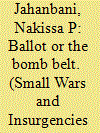

|
|
|
|
|
| Summary/Abstract |
In recent years, an upward trend in terrorist attacks has mirrored an increase in suicide attacks. According to our preliminary analysis, the events of September 11th marked a sea change in the number of terrorist attacks. While a rich literature has evaluated why terrorists participate in suicide attacks, none have considered the uptick in volume after 9/11, and fewer yet have considered how female fighters may be contributing to this. We evaluate how both structural and female-specific factors affect the likelihood of female fighter suicide attacks. Recent literature discovered a trend in terrorist groups using females as suicide bombers due to cultural norms that permit them to get closer to targets. We test our theory using data from the Chicago Project on Security and Threats Suicide Attack Database (CPOST-SAD) and various datasets from the Quality of Government (QOG) compendium for the 1986–2016 time period. We construct a series of models that consider both female-specific and structural factors that could explain variation in the number of female suicide attacks. Our results indicate that our models encompass relatively stable patterns. Female political empowerment, female educational attainment, and female employment rates are significant and positive in our post-9/11 models, indicating that they may increase female suicide attacks. Democracy is a relevant structural factor and generally yields a positive effect on female suicide attacks across both time periods and multiple models. Ethnic fractionalization is significant in both time periods but yields a negative effect before 9/11 and a positive effect in the later period.
|
|
|
|
|
|
|
|
|
|
|
|
|
|
|
|
| 3 |
ID:
178561
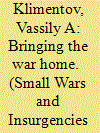

|
|
|
|
|
| Summary/Abstract |
Terrorism connected to the North Caucasus has been pervasive in Russia between 1992 and 2018. Based on an original dataset, this article presents statistics on rates of terrorist attacks outside of the North Caucasus, their geography and targets, and the tactics used. It argues that terrorism by North Caucasian insurgents has long retained a strategic logic despite their conversion to radical Islamism. Accordingly, the end of North Caucasian terrorism was determined by the erosion of its strategic character as an increasingly vague ideological project replaced concrete political goals among the insurgents.
|
|
|
|
|
|
|
|
|
|
|
|
|
|
|
|
| 4 |
ID:
138784
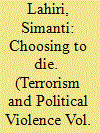

|
|
|
|
|
| Summary/Abstract |
Scholars tend to attribute the use of suicide protest and suicide bombing to purely rational considerations. In contrast, I argue that conventional understandings of strategy are too narrow and must be expanded to include emotional motivations for political mobilization. “Complex” strategy directly engages both the calculative and emotive understandings of political action. I develop this theory through a comparison of suicide protests and suicide bombings in South Asia, focusing on the emotional content of this extreme tactic. Suicide protests illustrate the importance of pride, sympathy, fear, and shame in political mobilization. I explore the emotional character of suicide in protest through an investigation of two cases: the Liberation Tigers of Tamil Eelam in Sri Lanka (LTTE) and the Narmada Bachao Andolan (NBA) in India.
|
|
|
|
|
|
|
|
|
|
|
|
|
|
|
|
| 5 |
ID:
079230
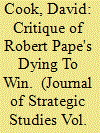

|
|
|
|
|
| Publication |
2007.
|
| Summary/Abstract |
Robert Pape's recent book Dying to Win is one of the most important statistical studies of the global phenomenon of suicide attacks to appear in the recent past. While Pape's basic thesis of the formula of occupation in addition to religious/cultural differences between the occupier and the occupied causing these suicide attacks holds up, there are a number of cases in which it does not. Additionally, some of Pape's historical and Islamic examples are weak. Before proceeding to an over-arching theory of suicide attacks it is important not to ignore the exceptions to Pape's theory.
|
|
|
|
|
|
|
|
|
|
|
|
|
|
|
|
| 6 |
ID:
079229
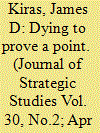

|
|
|
|
|
| Publication |
2007.
|
| Summary/Abstract |
Dying to Win is one of the most important works on suicide terrorism. It purports to unravel the strategic, social, and individual logic that gives suicide terrorism its coercive value. The methodology that Pape uses to support his various assertions is problematic for three reasons. First, he defines his key terms in such a way as to artificially set suicide terrorism apart from other forms of political violence. Second, in a number of cases Pape selects data from single sources to support particular assertions when other sources of data, used together, could provide more rigorous and useful insights into the phenomenon of suicide bombing. Finally, Pape codes his data on suicide attacks according to a loose set of criteria which, if recoded, calls into question some of his broader conclusions about the strategic utility of suicide terrorism campaigns.
|
|
|
|
|
|
|
|
|
|
|
|
|
|
|
|
| 7 |
ID:
093687
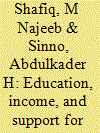

|
|
|
|
|
| Publication |
2010.
|
| Summary/Abstract |
The authors examine the effect of educational attainment and income on support for suicide bombing among Muslim publics in six predominantly Muslim countries that have experienced suicide bombings: Indonesia, Jordan, Lebanon, Morocco, Pakistan, and Turkey. The authors make two contributions. First, they present a conceptual model, which has been lacking in the literature. Second, they consider attitudes toward two different targets of suicide bombings: civilians within the respondent's country and Western military and political personnel in Iraq. The authors find that the effect of educational attainment and income on support for suicide bombings varies across countries and targets.The findings therefore draw attention to the difficulties of making generalizations about Muslim countries and the importance of distinguishing between targets of suicide bombings.
|
|
|
|
|
|
|
|
|
|
|
|
|
|
|
|
| 8 |
ID:
074761
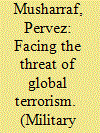

|
|
|
| 9 |
ID:
081344
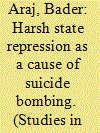

|
|
|
|
|
| Publication |
2008.
|
| Summary/Abstract |
Although students of social movements have established that state repression strongly affects protesters' choice of tactics, this finding has been ignored by most analysts of suicide bombing. Based on data collected from various sources, including 88 interviews the author conducted in 2006 with senior leaders of six Palestinian political organizations and close relatives and friends of Palestinian suicide bombers, this article argues that harsh state repression is a major cause of suicide bombing. It shows that understanding the effect of state repression is crucial to clarifying many of the unsolved puzzles concerning the rationales of organizations that employ suicide bombing, the motivations of individual suicide bombers, and the reasons why this tactic has become popular in some societies. The article concludes that there are three types of organizational rationales underlying the use of suicide bombing. Suicide bombing may be an extreme reaction to extreme state repression, a combined reactive and strategic action, or a purely strategic action. Different contexts and organizations typify these organizational rationales.
|
|
|
|
|
|
|
|
|
|
|
|
|
|
|
|
| 10 |
ID:
133542


|
|
|
|
|
| Publication |
2014.
|
| Summary/Abstract |
A number of observers have expressed serious concerns that Al-Qaeda in the Islamic Maghreb (AQMI), as it expands in the Sahel, may become strong enough to be a threat to Europe and carry on the global mission of Al-Qaeda as conceived by bin Laden. This fear seems unwarranted. Using institutional analysis to study the AQMI behavioral fluctuations over the last decade, this article argues that AQMI's need to find a compromise between external and internal legitimacy has constrained its behavior. The affiliation of the Algerian terrorists with Al-Qaeda was in many ways a marriage of convenience that created a number of internal contradictions. At the cognitive level, implicit Algerian nationalism to rid the country of its corrupt regime remains at odds with pan-Islamic views shared by Al-Qaeda's leadership. At the normative level, indiscriminate suicide bombing supported by Al-Qaeda is abhorrent to many Algerian terrorists, who construe their mandate in the spirit of the Algerian war of independence where it is their duty to protect civilians. These and other contradictions prevent AQMI from developing a coherent political agenda and thus it is less likely to engage in a long-term conflict against European societies.
|
|
|
|
|
|
|
|
|
|
|
|
|
|
|
|
| 11 |
ID:
154998
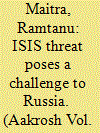

|
|
|
| 12 |
ID:
124627


|
|
|
|
|
| Publication |
2013.
|
| Summary/Abstract |
This article sets out to interrogate the relationship between Liberalism and suicide bombing. It maps and critically examines accounts of suicide bombing as a practice diametrically opposed to the secular logics of liberal governance, or as the direct expression of the traces of sovereign exceptionalism that haunt the global operation of Liberal biopower. I argue that a uniquely liberal analytic of human finitude establishes conditions of political intelligibility for suicide bombings today. As such, the contemporary politics of suicide may be understood as in critical communication with liberal political theologies of immanent governance over the human qua mortal, rather than as structurally deriving from political theologies of sovereign power.
|
|
|
|
|
|
|
|
|
|
|
|
|
|
|
|
| 13 |
ID:
083696
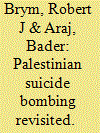

|
|
|
|
|
| Publication |
2008.
|
| Summary/Abstract |
Robert J. Brym and Bader Araj contest Mia Bloom's outbidding thesis, which holds that suicide attacks are a currency for outbidding rivals in the competition for popular support. They find that public opinion data are inconsistent with the outbidding thesis and argue that support for suicide bombing is more a function of social solidarity than competition within the Palestinian community
|
|
|
|
|
|
|
|
|
|
|
|
|
|
|
|
| 14 |
ID:
163189
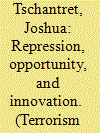

|
|
|
|
|
| Summary/Abstract |
How does state repression affect the incidence and impact of terrorism? This study conducts a process tracing analysis of the ongoing contention between the Uyghur separatist movement and the Chinese state to provide a plausible explanation for the present lack of consensus on this question. Relying on insights from collective action theory, it argues that although repression was initially successful in curtailing the opportunistic use of terrorism, novel political opportunity allowed some separatists to adopt innovations, such as suicide bombing, to circumvent repression. Repression has since proved ineffective in quelling terrorism, and will likely remain incapable of forestalling future terrorist innovations.
|
|
|
|
|
|
|
|
|
|
|
|
|
|
|
|
| 15 |
ID:
072509
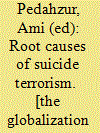

|
|
|
|
|
| Publication |
London, Routledge, 2006.
|
| Description |
xix, 202p.
|
| Standard Number |
0415770300
|
|
|
|
|
|
|
|
|
|
|
|
Copies: C:1/I:0,R:0,Q:0
Circulation
| Accession# | Call# | Current Location | Status | Policy | Location |
| 051386 | 363.325/PED 051386 | Main | On Shelf | General | |
|
|
|
|
| 16 |
ID:
091359


|
|
|
| 17 |
ID:
115358
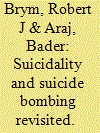

|
|
|
|
|
| Publication |
2012.
|
| Summary/Abstract |
Ariel Merari purports to demonstrate a tendency on the part of suicide bombers to be motivated by depression and suicidal tendencies. However, he misconstrues the present authors' critique of his work and misinterprets their research. By clarifying both issues, this article seeks to substantiate three claims: (1) Merari's sampling procedure precludes generalization; (2) interviewer and contextual effects probably bias his findings; (3) evidence challenges his inferences.
|
|
|
|
|
|
|
|
|
|
|
|
|
|
|
|
| 18 |
ID:
134991


|
|
|
|
|
| Summary/Abstract |
Extending data reported by Mohammed Hafez in 2007, we compiled a database of 1,779 suicide bombers who attempted or completed attacks in Iraq from 2003 through 2010. From 2003 through 2006, monthly totals of suicide bombers show a pattern different from the pattern of non-suicide insurgent attacks, but from 2007 through 2010 the two patterns were similar. This biphasic pattern indicates that suicide attacks sometimes warrant separate analysis but sometimes are just one tactic in a larger envelope of insurgent violence. We also show that only 13 percent of suicide bombers targeted coalition forces and international civilians, primarily during the early years of the conflict, whereas 83 percent of suicide bombers targeted Iraqis (civilians, members of the Anbar Awakening Movement, Iraqi security forces, and government entities) in attacks that extended throughout the duration of the insurgency. These results challenge the idea that suicide attacks are primarily a nationalist response to foreign occupation, and caution that “smart bombs” may be more often sent against soft targets than hard targets. More generally, our results indicate that suicide attacks must be disaggregated by target in order to understand these attacks as the expression of different insurgent priorities at different times.
|
|
|
|
|
|
|
|
|
|
|
|
|
|
|
|
| 19 |
ID:
103206
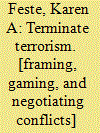

|
|
|
|
|
| Publication |
Boulder, Paradigum Publishers, 2010.
|
| Description |
ix, 259p.
|
| Standard Number |
9781594518218, hbk
|
|
|
|
|
|
|
|
|
|
|
|
Copies: C:1/I:0,R:0,Q:0
Circulation
| Accession# | Call# | Current Location | Status | Policy | Location |
| 055908 | 363.325/FES 055908 | Main | On Shelf | General | |
|
|
|
|
| 20 |
ID:
082145
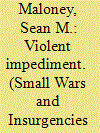

|
|
|
|
|
| Publication |
2008.
|
| Summary/Abstract |
Theorizing about Taliban operations in Afghanistan has its limits and it is possible that Kabul-centric strategies do not adequately address the unique circumstances of each region in the country. How exactly has the Taliban gone about attaining its objectives in Kandahar province and how have those approaches evolved since 2002? And how have the Taliban adapted to coalition forces' attempts to compete with the insurgency and stamp it out? The answers to these questions are critical in the formulation of any counterinsurgency approach to Afghanistan
|
|
|
|
|
|
|
|
|
|
|
|
|
|
|
|
|
|
|
|
|